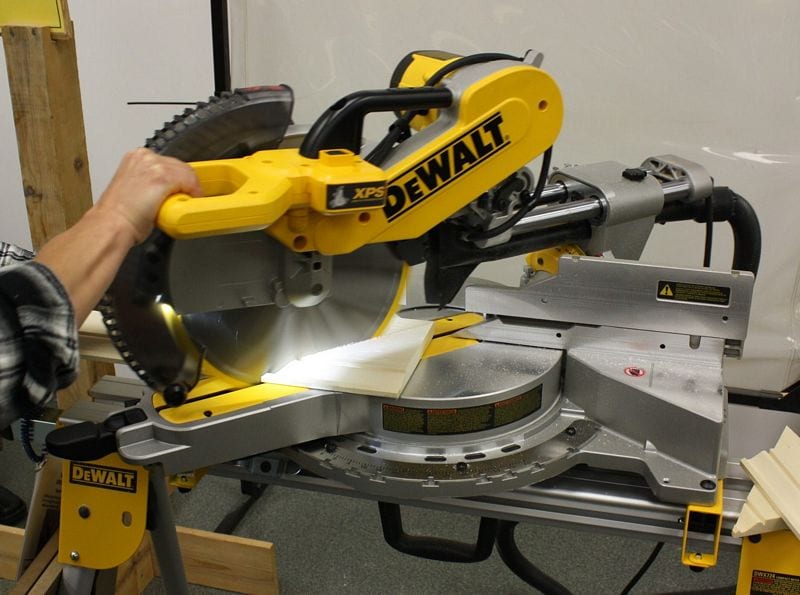A dual bevel miter saw is a versatile power tool used in woodworking and construction. It combines two essential features: mitering (making angled cuts across the width of a workpiece) and beveling (tilting the blade for angled cuts along the thickness of a workpiece).
Moreover, this tool can pivot in both directions, making it efficient, precise, and versatile for tasks like crown molding and complex angle cuts. It’s commonly used by professionals and DIY enthusiasts for a wide range of projects.
What Are The Components of a Dual Bevel Miter Saw?
The dual bevel miter saw, a pinnacle of cutting precision, comprises several key components that work in harmony to facilitate versatile and accurate angled cuts
Blade
The blade is the heart of any miter saw. It is a circular saw blade specifically designed for making precise and angled cuts. Blades come in various sizes and tooth configurations, allowing for different types of cuts, from crosscuts to bevel cuts.
In addition, dual bevel miter saws typically accommodate various blade sizes and have adjustable blade speed settings for different materials.
Base

The base is the foundation of the miter saw, providing stability and support during cutting operations. It often includes a table with extensions that can be adjusted to accommodate longer workpieces.
In addition, some bases have integrated clamps or vices to secure the workpiece in place, ensuring accuracy.
Bevel Adjustment
Bevel adjustment allows the user to tilt the blade to make bevel cuts at different angles. Dual bevel saws can tilt the blade in both directions (left and right), making them highly versatile.
Furthermore, the bevel adjustment typically has positive stops at common angles, making it easy to set precise bevel cuts.
Miter Adjustment
Miter adjustment controls the horizontal angle at which the blade cuts. It enables the saw to make angled cuts, such as miters and compound miters.
Like bevel adjustment, miter adjustment often has preset detents at common angles for quick and accurate adjustments.
Fence:
The fence is a guide that helps keep the workpiece stable and perpendicular to the blade during cuts.
It can often be adjusted for different angles to accommodate various cutting requirements.
A well-aligned fence is crucial for achieving accurate and repeatable cuts.
Dust Collection System:
Many dual bevel miter saws are equipped with a dust collection system, consisting of a dust port and a vacuum or dust bag.
Furthermore, this system helps keep the workspace clean by collecting sawdust and debris generated during cutting.
Effective dust collection not only maintains a cleaner working environment but also improves visibility and safety.
How Does a Dual Bevel Miter Saw Work?
A dual bevel miter saw is a marvel of engineering, operating with precision to create angled cuts in two directions effortlessly.
Cutting Angles:
Dual bevel miter saws can make a wide range of cuts, including miter cuts (angled in the horizontal plane) and bevel cuts (angled in the vertical plane).
Moreover, users can adjust both the miter and bevel angles to achieve compound cuts, allowing for complex joinery and precise finishing.
Dual Bevel Feature Explained:
The dual bevel feature means that the saw can tilt the blade in both the left and right directions, without the need to flip the workpiece.
In addition, this feature is especially useful for cutting complex angles and bevels on moldings, frames, and other woodworking projects, as it eliminates the need to reposition the material.
Sliding vs. Non-Sliding Dual Bevel Miter Saws
| Feature | Sliding Dual Bevel Miter Saw | Non-Sliding Dual Bevel Miter Saw |
| Sliding Feature | Yes | No |
| Blade Movement | Forward and backward along a rail system | Fixed in place |
| Cutting Capacity | Wider workpieces due to the sliding feature | Limited to the fixed cutting capacity |
| Compactness | Bulkier due to the sliding mechanism | More compact and space-efficient |
| Suitable Workshops | Larger workshops or jobs that require cutting wide boards | Smaller workshops or jobs that don’t need to cut wide boards |
| Versatility | Versatile for a wide range of cutting tasks | Limited to smaller workpieces |
| Precision and Accuracy | May require more adjustments for precise cuts | Easier to set up for precise cuts |
| Price | Generally more expensive | Often more affordable |
Final Words
In conclusion, the dual bevel miter saw stands as a pivotal tool in the arsenal of woodworkers and carpenters alike. Its versatile nature, with the ability to make precise miter and bevel cuts, grants craftsmen the power to create intricate joinery, flawless moldings, and perfect angles with ease.
The precision and accuracy it offers reduce the margin for error, resulting in tighter-fitting joints and professional-grade finishes.
Additionally, its time-saving capabilities expedite project completion, making it a valuable asset for those who value efficiency.
